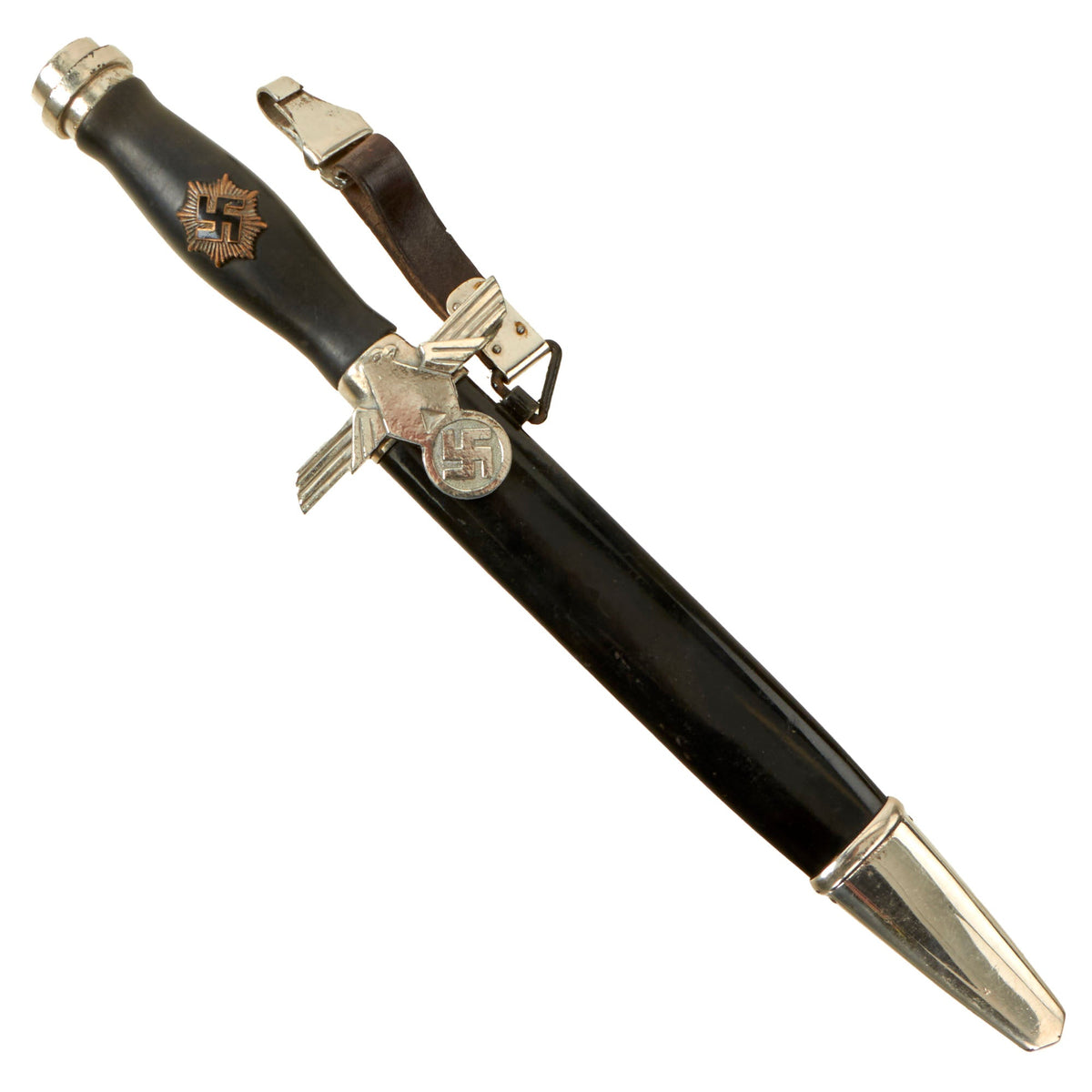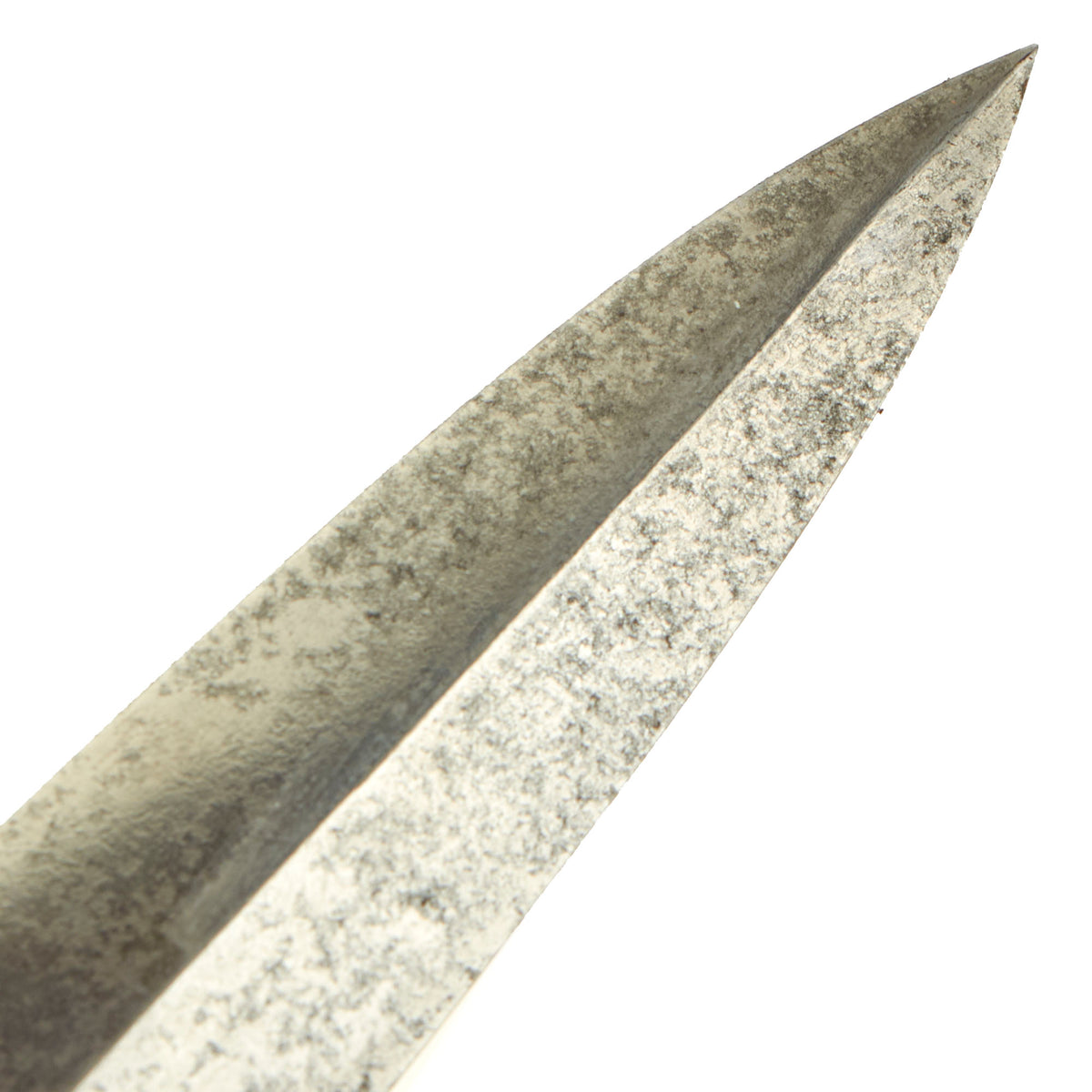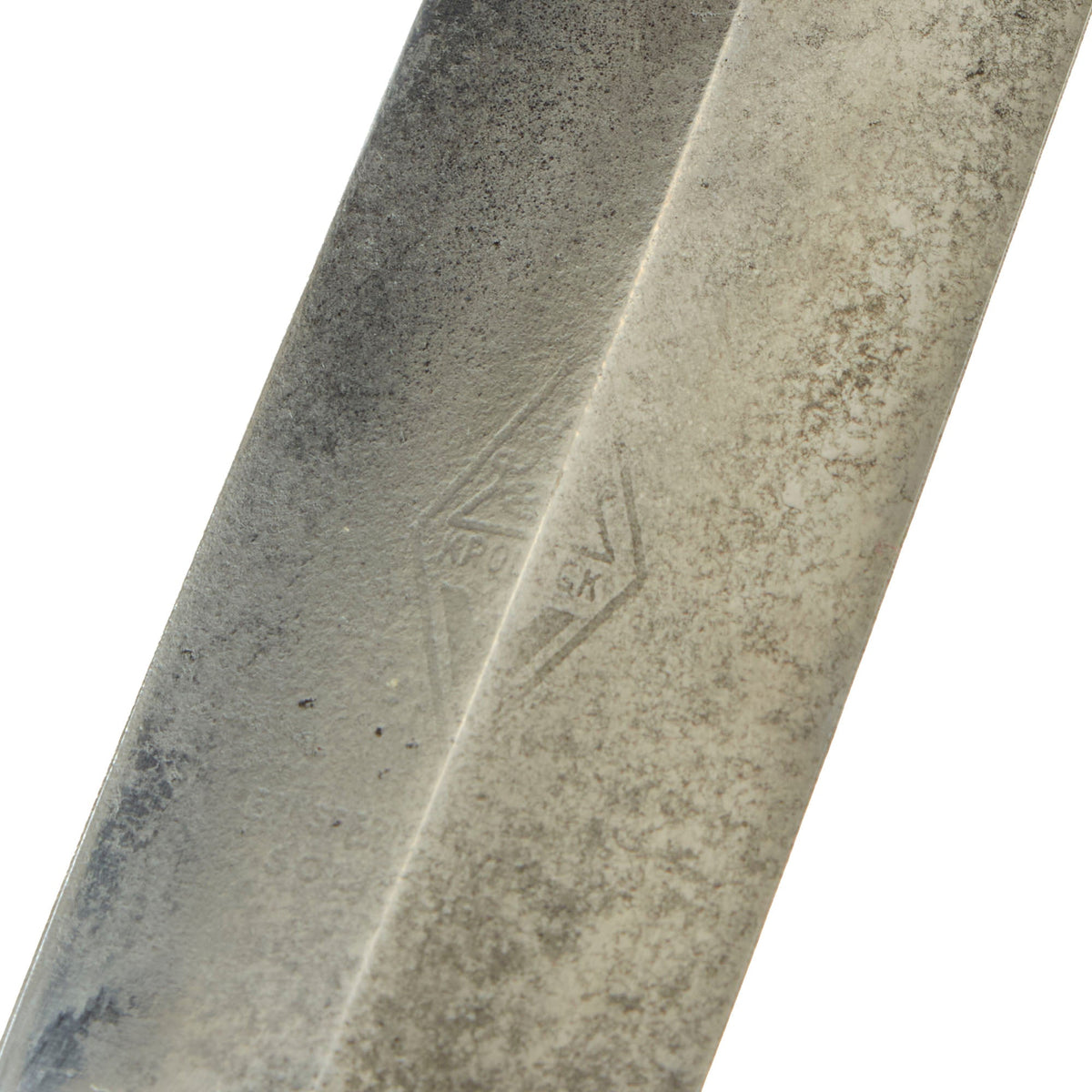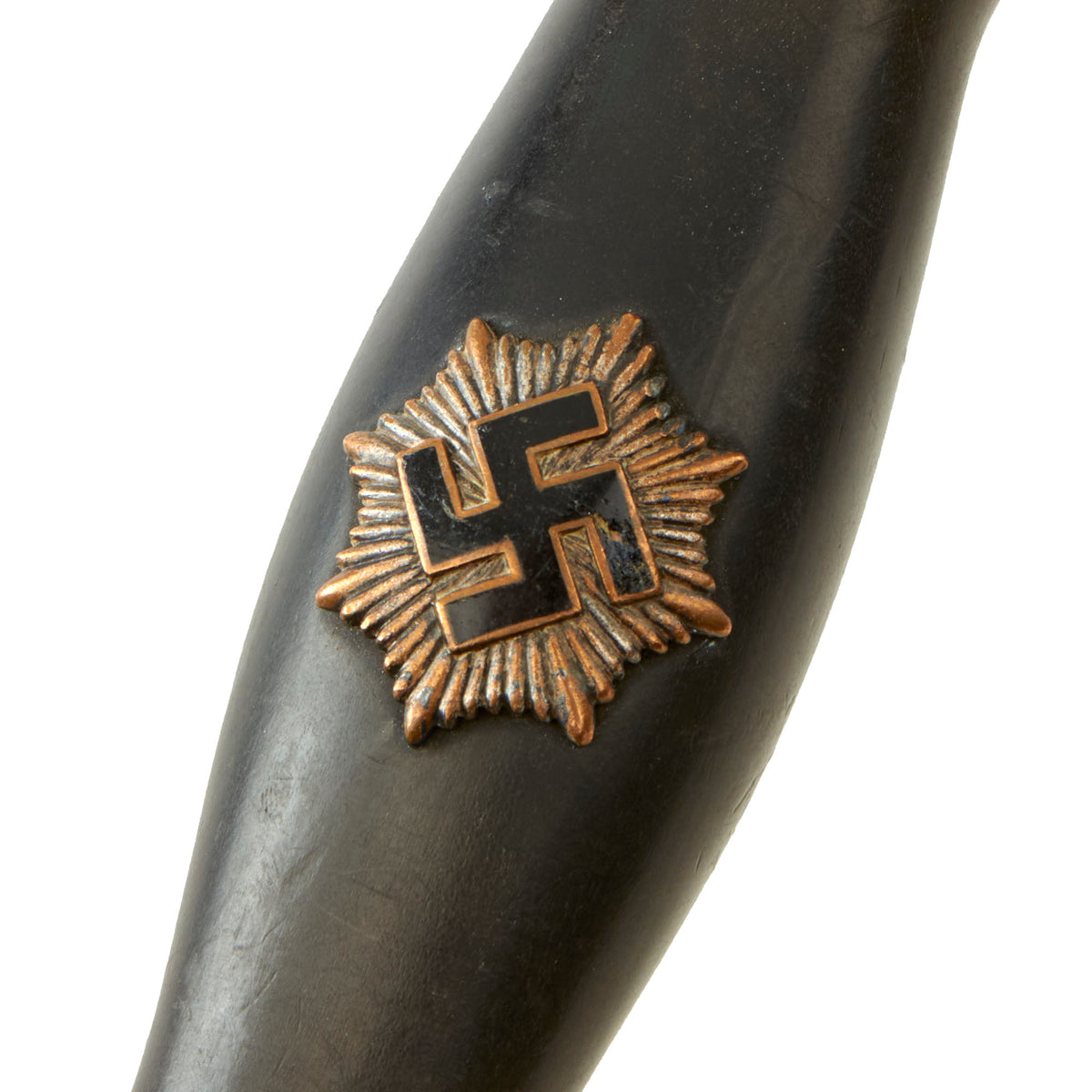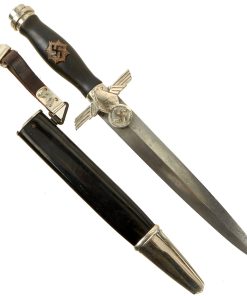Original German WWII 2nd Model Enlisted Man’s RLB Dagger by KRONECK Ernst Erich Witte of Solingen with Scabbard and Hanger Original Items
$ 1.495,00 $ 373,75
Original Item: Only One Available. This RLB EM Dagger is in very good condition throughout. The hilt mounts are the nickel-plated pot metal type. The plating does show some wear and flaking in areas, particularly on the pommel fitting, which shows some corrosion on the edges, as we often see. The pommel is in the characteristic derby shape with an equatorial band. The cross guard features a stubby-winged Art Deco-style eagle clutching a smooth wreath and swas. The quillons are decorated with cut lines and the ends are cut at 45 angles, presumably to impart a look of motion. The hilt is still tightly attached to the blade tang, with no wiggle.
The grip is a fine ebony example. It retains much of the original sheen finish and is in very good condition, showing some very light pressure denting. The insignia is the style with an enamel swas (hook cross) over a background sunburst. it has lost all of the original plating, now showing the copper base metal beneath. There is also a bit of light chipping on the enamel.
The blade of this dagger is in good shape, retaining much of the original factory crossgrain. This texture is iconic, and is the definitive identifying characteristic for a real WWII German Blade. It has however suffered past oxidation staining and light corrosion, which was then cleaned away, especially on the back. This has removed the crossguard in areas, and has made the maker mark on the blade quite faint.
This example is faintly marked with on the back with the “KRONECK” trademark address logo of Ernst Erich Witte, Stahlwarenfabrik (Steelware Factory) of Solingen, the legendary “City of Blades” in western Germany. This features “a crown on a triangle above KRONECK” marking within a diamond above a large letter W:
(Crown On Triangle)
KRONECK
W
ERNST ERICH WITTE
S O L I N G E N
Per J. Anthony Carter’s fine work GERMAN SWORD AND KNIFE MAKERS, this company was founded in 1914 and registered with Solingen authorities in 1920. It produced edged weapons during the Third Reich period, including SA and RLB daggers marked with the trademark above the firms name and address marking. They also made RAD officer’s daggers, and the company survived WWII, eventually closing in 1963.
The scabbard is in excellent condition, showing no denting or bends in the steel body. The original black enamel paint is well retained at over 95%, showing just a bit of crazing due to age, and just a few spots where the paint has chipped away. It even has the name James J Yosick scratched very gently into the back, most likely the USGI that brought it back! The plated steel mounts are in good shape, with just a bit of speckled patination.
Attached to the scabbard is the triangular hanger retainer wire, which still a fully intact hanger strap with nickel plated steel fittings. The end clip is marked with marked with a “barred A” followed by D.R.G.M. (Deutsches Reiches Gebrauchs Musterschutz) – meaning it is a protected patented design under the Reich Government. This design was registered to the owner of the “Barred A” trademark, F. W. Assmann & Söhne of Lüdenscheid, a large maker of belts, buttons, and other accoutrements. The clip also has the RZM code M5/8 for Assmann, correct for a plated steel example. The leather is still in great shape, and the clip fully functional.
A lovely example of the RLB dagger by a rare maker, always hard to find in such nice condition!
Specifications:
Blade Length: 8 3/4″
Blade Style: Double Edged Spear Point
Overall length: 13 3/4“
Crossguard: 3 1/4”
Scabbard Length: 9 1/4″
The Reichsluftschutzbund (RLB) (National Air Raid Protection League) was an organization in NSDAP Germany in charge of air raid precautions in residential areas and among smaller businesses. The RLB was organized by Hermann Göring in 1933 as a voluntary association. Existing volunteer air raid precaution associations were forced to merge with RLB. In 1939 the RLB became a Körperschaft des öffentlichen Rechts (quasi-autonomous non-governmental organization), while in 1944 it became an affiliated organization of the NSDAP Party. RLB was dissolved by the Allied Powers after the end of World War II. Its successor in the Federal Republic of Germany was the Bundesverband für den Selbstschutz.
The RLB was in charge of educating and training ordinary German men and women in civil defence procedures necessary for the basic level of local self-help of the civil population against air raids. The local level was formed around air raid wardens and operated in small first intervention squads. The training include fire fighting, protection against chemical weapons, communication procedures and preparation of houses and apartments against air raids.
In 1939 the RLB had about 15 million members, 820 000 volunteer functionaries (of which 280,000 women) and 75,000 local units. The membership was trained at 3,800 civil defense schools with 28,000 instructors.
– RLB was led by a Präsidium, whose president, and vice president and chief of staff, were active duty general officers of the Luftwaffe. The presidium was in itself a department immediately subordinated to the Ministry of Aviation.
– Coterminous with each Luftgaukommando (air district command) was a RLB-Gruppe (RLB-group) under a leader aided by 46 full-time staff members.
– For each Regierungsbezirk, there was a RLB-Bezirksgruppe (regional group).
– The basic organization was the RLB-Revier, one for each police precinct in the cities, or the RLB-Gemeinde-Gruppe, one for each urban or rural municipality for the rest of the country. In the case of a city with several precincts, the citywide organization was called an RLB-Ortsgruppe (local group). Several municipal groups formed an RLB-Ortskreisgruppe, one for each Landkreis. Each Ortsgruppe and Ortskreisgruppe had a leader and a staff of nine members, of which five where full-time salaried employees.
– The basic organizations had a varied number of Untergruppen (sub-groups) divided into Blocke (blocks) under Blockwarte (block wardens) which controlled and liaised with a number of Luftschutzgemeinschafte (air raid protection communities) under Luftschutzwarte (air raid wardens). Each community consisted of an apartment building or several smaller buildings, although a large apartment complex could have several communities. In addition to the warden, the community should have an assistant warden, house fire fighters, helpers and messengers as a first intervention squad. Duty in these squads were compulsory (Notdienstpflicht) for the civilian population.
Fast Shipping with Professional Packaging
Thanks to our longstanding association with UPS FedEx DHL, and other major international carriers, we are able to provide a range of shipping options. Our warehouse staff is expertly trained and will wrap your products according to our exact and precise specifications. Prior to shipping, your goods will be thoroughly examined and securely secured. We ship to thousands clients each day across multiple countries. This shows how we're dedicated to be the largest retailer on the internet. Warehouses and distribution centres can be located throughout Europe as well as the USA.
Note: Orders with more than one item will be assigned a processing date depending on the item.
Before shipping before shipping, we'll conduct a thorough inspection of the items you have ordered. Today, the majority of orders will be delivered within 48 hours. The delivery time will be between 3-7 days.
Returns
The stock is dynamic and we cannot completely manage it because multiple stakeholders are involved, including our factory and warehouse. So the actual stock may alter at any time. It's possible that you may not receive your order once the order has been made.
Our policy is valid for a period of 30 days. If you don't receive the product within 30 days, we are not able to issue a refund or an exchange.
You can only return an item if it is unused and in the same state as the day you received it. You must have the item in its original packaging.
Related products
Uncategorized
Uncategorized
Uncategorized
Uncategorized
Uncategorized
Uncategorized
Angolan Rebel 1970s era 60mm Inert Display Mortar from Angolan Civil War Original Items
Uncategorized
Uncategorized
Uncategorized
Uncategorized
Uncategorized
Uncategorized
Uncategorized
Uncategorized
Uncategorized
Uncategorized
Armored Burgonet Helmet & Polearm from Scottish Castle Leith Hall Circa 1700 Original Items
Uncategorized
Band of Brothers ORIGINAL GERMAN WWII Le. F.H. 18 10.5cm ARTILLERY PIECE Original Items
Uncategorized


